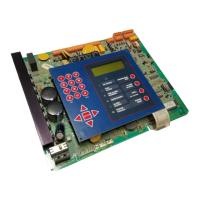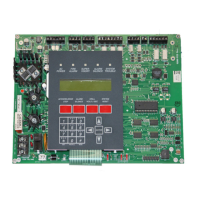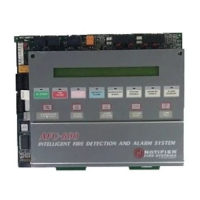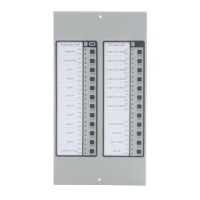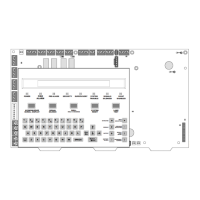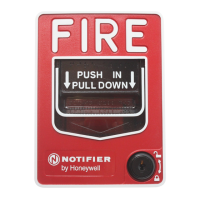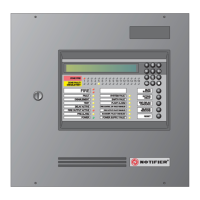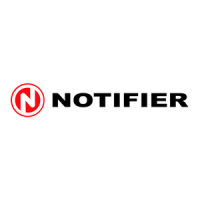




Do you have a question about the Notifier AFP1010 and is the answer not in the manual?
| Type | Fire Alarm Control Panel |
|---|---|
| Manufacturer | Notifier |
| Model | AFP1010 |
| Zones | Up to 10 |
| Operating Temperature | 32°F to 120°F (0°C to 49°C) |
| Max Detectors | 159 detectors per loop |
| Max Modules | 159 modules per loop |
| Battery Backup | 24-hour backup with 7 AH batteries |
| Annunciators | Up to 32 |
| Networking | Supports Noti-Fire-Net |
| Display | LCD |
| Communication Ports | RS-232 |
| Humidity Range | 10% to 93% noncondensing |
| Dimensions | 14.5" x 16.5" x 4.5" (368 mm x 419 mm x 114 mm) |
| Mounting | Surface Mount |
Overview of the AM2020/AFP1010 Combination Fire/Security Protective Signaling System and its features.
Details the device capacity and system capabilities of the AM2020/AFP1010.
Lists applicable NFPA and UL standards for fire alarm system installations.
Provides an overview of the installation process and system components.
Details the basic equipment package included with the AM2020/AFP1010.
Lists documentation and software for understanding system features and functions.
Guidance on selecting cabinets and installing system components.
Describes the basic components of the cabinet assembly and general features.
Instructions for mounting the cabinet backbox.
Step-by-step guide for assembling and mounting the cabinet door.
Details the CAB-3 series backboxes and their available replacement parts.
Instructions for mounting the ICA-4L chassis.
Guidelines for placing system components within the cabinet.
Information on display interface assemblies and other system components.
Describes how to connect the display interface to the system CPU and optional boards.
Details on power supplies required for the AM2020/AFP1010 system.
Instructions for connecting the primary AC power source.
Description of the main power supply and its capabilities.
Guidance on connecting primary and secondary power sources.
Information on installing and connecting the remote battery charger.
Details on mounting and wiring the APS-6R auxiliary power supply.
Covers signaling circuits and devices used in the system.
Explains the Loop Interface Board (LIB) and its signaling line circuit functions.
Specifies wiring requirements for LIB SLC loops, including styles and resistance.
Describes the function and application of the Loop Isolator Module (ISO-X).
Details the CMX Control Module for notification appliance circuits and Form-C relays.
Provides instructions for installing intelligent smoke detectors.
Covers serial communication components like interface boards, CRT terminals, and printers.
Describes optional serial interface boards such as SIB-2048A and SIB-NET.
Details the CRT-2 terminal features, specifications, and installation.
Outlines system requirements based on NFPA and UL standards.
Specific requirements for NFPA 72-1993 Auxiliary Fire Alarm Systems.
Instructions for supervising uninterruptable power supplies.
Provides an overview of the AM2020/AFP1010 operation and system features.
Explains how the panel's intelligent detectors and modules provide information.
Describes the three operational levels and password requirements.
Explains the format for entering device, zone, or annunciator point addresses.
Details the dual purpose of the backspace key for menu prompts and data entry.
Explains how to enter alphanumeric characters on the DIA keypad.
Describes the Walk Test feature for testing devices on selected LIBs.
Details the system display and operator functions during normal operation.
Allows the operator to display the status of the entire system.
Provides information on programmed system parameters like LIBs, AVPS, zones, etc.
Displays status information for detectors, modules, zones, or points.
Explains how device and system trouble conditions are displayed.
Details the format for displaying device trouble conditions.
Explains the format for displaying system trouble conditions.
Provides clarification for self-explanatory trouble messages.
Overview of programming options for the AM2020/AFP1010 system.
Basic procedure for initial programming to prevent errors and wasted time.
Accesses the Main Programming menu with eight options.
Allows selective programming of system-wide functions.
Enables complete programming of system-wide functions.
Allows altering operational parameters of SLC Loop devices, zones, and points.
Enables complete programming of all addressable devices, zones, and points.
Details options for partial system programming.
Allows installation or removal of Loop Interface Boards from memory.
Enables changing the NFPA style for SLC Loops in memory.
Allows setting time delays for Alarm Verification, Signal-Silence, and Signal Cut-Out.
Enables/disables panel piezo, LIB local mode, NFPA listings, and battery parameters.
Allows changing parameters for Intelligent Serial Interface Boards (ISIBs).
Allows changing operational parameters for SLC Loop devices, zones, and points.
Allows changing the Software Type ID for devices, zones, and points.
Allows redefining the Control-By-Event for detectors, modules, or zones.
Enables/disables Signal Silence, Walk Test, Alarm Verification, Sensitivity, and Tracking.
Allows mapping devices or zones to annunciator points for remote annunciation.
Enables complete programming of all addressable detectors, modules, zones, and points.
Provides access to modify system status parameters.
Allows disabling and re-enabling individual devices or zones.
Performs system diagnostics.
Selects LIBs for walk test and generates reports.
Details programming responses based on event combinations.
Explains Control-By-Event (CBE) programming for system responses.
Describes operators like OR, AND, NOT, XZONE, DEL, SDEL, and TIM.
Details the physical size limitations for Control-By-Event in panel memory.
Covers installation and programming for combined fire/security systems.
Introduces security system suitability and requirements.
Outlines essential security requirements for system installation.
Guidance on selecting and placing security devices in different areas.
Lists common security devices for building perimeters and their applications.
Explains the process for assigning zone numbers for application engineering.
Provides programming keys for the simplest security system configuration.
Details programming keys for a multiple tenant simple security system.
Provides programming keys for a multiple tenant simple security system.
Details programming keys for a single tenant consolidated security system.
Programming keys for multiple tenant consolidation security systems.
Programming keys for single tenant security systems with entry/exit delay.
Illustrates connecting an MMX-101 module to the RKS-S.
Illustrates connecting an MMX-1 module to the RKS-S.
Outlines various circuits and devices with their ratings and wire requirements.
General overview of Appendix A.
Discusses specific wire types and gauges for system circuits.
Lists UL-compatible equipment for the AM2020/AFP1010.
Lists optional system components available for the AM2020/AFP1010.
Worksheets for recording system input parameters.
Worksheets for recording system output parameters.
Worksheets for programming system software zones.
Defines terms and abbreviations used throughout the manual.
